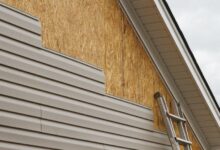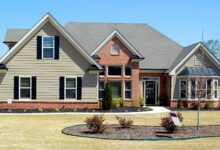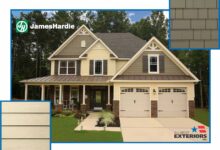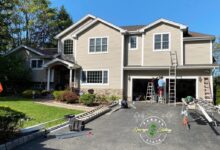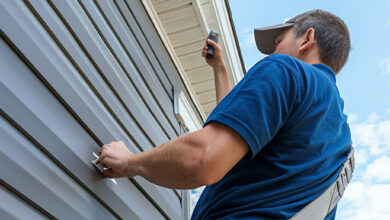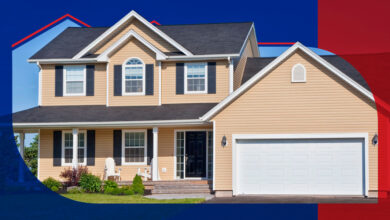Siding Companies Near Me: A Comprehensive Guide
Siding companies near me offer a range of services crucial for home improvement and maintenance. Understanding the options available, from vinyl to wood and fiber cement siding, is key to making an informed decision. This guide explores the process of finding reputable contractors, evaluating their bids, and navigating the installation process, ensuring your project runs smoothly and delivers lasting results. We’ll also cover crucial post-installation care to maintain your siding’s beauty and longevity.
Choosing the right siding can significantly impact your home’s curb appeal and energy efficiency. This guide helps you navigate the complexities of selecting materials, finding reliable contractors, and managing the entire process, from initial consultation to final inspection. We aim to provide you with the knowledge and resources to make confident choices, ensuring a successful siding project.
Understanding Local Siding Companies
Choosing the right siding for your home is a significant investment, impacting both its aesthetic appeal and long-term durability. Understanding the services, materials, and pricing structures offered by local siding companies is crucial for making an informed decision. This section provides a comprehensive overview to aid you in this process.
Typical Services Offered by Local Siding Companies
Local siding companies typically offer a comprehensive range of services beyond simple installation. These often include a free consultation and estimate, removal of existing siding (if necessary), siding installation, repair of existing siding, and sometimes even painting or staining of the new siding. Many companies also handle related exterior projects like window and door trim installation or gutter repair, offering a one-stop shop for exterior home improvements. Some may even specialize in specific siding materials, such as fiber cement or metal.
Siding Material Comparisons
Several siding materials are commonly available, each with its own set of advantages and disadvantages. Vinyl siding is a popular choice due to its affordability and low maintenance requirements. It’s relatively easy to install and comes in a wide variety of colors and styles. However, it’s not as durable as other options and can be susceptible to damage from impact. Wood siding offers a classic, natural look but requires more maintenance, including regular painting or staining to prevent rot and insect damage. It’s also generally more expensive than vinyl. Fiber cement siding combines the durability of cement with the aesthetic appeal of wood, offering excellent resistance to fire, insects, and rot. It is, however, more expensive and heavier than vinyl siding, requiring more robust installation techniques.
Pricing Structures for Siding Installation Projects
The cost of siding installation varies considerably depending on several factors. The size of the house, the type of siding chosen, the complexity of the installation (e.g., presence of dormers or intricate trim), and the labor costs in your specific region all play a role. For example, a small house with simple vinyl siding might cost between $5,000 and $10,000, while a larger home requiring fiber cement siding and intricate detailing could easily exceed $20,000. It’s crucial to obtain multiple estimates from different contractors to compare pricing and services. Remember to clarify what is included in each estimate to ensure accurate comparison. Some contractors may charge per square foot, while others provide a fixed price for the entire project.
Typical Warranty Periods Offered by Siding Contractors
Warranty periods vary widely among siding contractors and depend on both the siding material and the contractor’s policies. Manufacturers typically offer warranties on their siding products, ranging from 10 to 50 years, depending on the material. Contractors usually provide a separate warranty on their workmanship, typically covering defects in installation for a period of 1 to 5 years. It’s essential to carefully review both the manufacturer’s warranty and the contractor’s warranty before signing any contract. Pay close attention to the specific terms and conditions of each warranty, including what is covered and what is not. For example, some warranties may exclude damage caused by acts of God or improper maintenance.
Finding and Evaluating Local Contractors
Choosing the right siding contractor is crucial for a successful project. A thorough evaluation process will protect your investment and ensure a quality outcome. This section details methods for identifying reputable companies and evaluating their qualifications.
Finding reputable siding companies in your area requires a multi-pronged approach. Leveraging online resources and local networks is key to identifying trustworthy professionals.
Identifying Reputable Siding Companies
Several avenues exist for finding reputable siding contractors. Online directories, such as those provided by the Better Business Bureau (BBB) or Angie’s List, offer reviews and ratings from past clients. Local home improvement stores often maintain lists of contractors they work with, providing a degree of pre-screening. Seeking referrals from friends, family, or neighbors who have recently had siding work done can also yield valuable insights. Finally, checking online review platforms like Yelp or Google Reviews can provide a broad overview of public opinion on various companies.
Factors to Consider When Evaluating a Company’s Reputation
Evaluating a siding contractor’s reputation requires a careful assessment of several key factors. A strong track record, demonstrated through positive reviews and a history of completed projects, is paramount. Experience and specialization in siding installation are equally important. Furthermore, investigating the company’s licensing and insurance coverage ensures legal compliance and protection against potential liabilities. Finally, examining their communication style and responsiveness to inquiries offers a glimpse into their professionalism and customer service approach.
Verifying a Company’s Licensing and Insurance
Before engaging a siding contractor, verifying their licensing and insurance is essential. Contact your state’s contractor licensing board to confirm the company’s license is valid and in good standing. Request proof of general liability insurance and workers’ compensation insurance. This documentation protects you from potential financial burdens should accidents or damages occur during the project. Confirm the policy numbers and contact the insurance companies directly to verify coverage. This thorough check safeguards your interests and ensures the contractor operates legally and responsibly.
Comparing Contractor Bids
A standardized approach to comparing bids from multiple contractors ensures a fair and informed decision. A comparison template should include detailed breakdowns of costs, including materials, labor, permits, and cleanup. Services offered should also be explicitly listed, including warranties, project timelines, and payment schedules. Including a column for notes allows for recording any pertinent observations or questions about each bid. This structured approach facilitates a clear comparison and aids in selecting the most suitable contractor for your needs.
| Contractor Name | Total Cost | Materials Cost | Labor Cost | Permit Costs | Warranty | Project Timeline | Payment Schedule | Notes |
|---|---|---|---|---|---|---|---|---|
| Contractor A | $15,000 | $5,000 | $10,000 | $0 | 10 years | 4 weeks | 50% upfront, 50% on completion | Responded quickly to inquiries |
| Contractor B | $17,000 | $6,000 | $11,000 | $0 | 5 years | 6 weeks | 25% upfront, 25% at milestones, 50% on completion | Seemed less experienced |
The Siding Installation Process
Siding installation is a multifaceted process requiring skilled labor and careful planning. A successful project hinges on meticulous preparation, precise execution, and a thorough understanding of building codes and best practices. The entire process, from initial site preparation to final cleanup, impacts the longevity and aesthetic appeal of your home’s exterior.
A typical siding installation project involves several key stages. These stages are interconnected, and any shortcomings in one area can negatively affect the others. For instance, inadequate preparation can lead to delays and increased costs, while improper installation can compromise the building’s weather resistance and structural integrity. The entire process should be approached systematically to ensure a high-quality, long-lasting result.
Site Preparation and Old Siding Removal
Preparing the home for new siding involves several crucial steps. First, the existing siding must be carefully removed. This process requires caution to avoid damaging underlying sheathing or causing unnecessary debris. Any damaged sheathing or underlying structural components should be repaired or replaced before new siding installation begins. Landscaping, such as shrubs and flowerbeds, should be protected with tarps or other suitable barriers to prevent damage from falling debris or construction activities. This proactive approach minimizes potential cleanup and prevents landscaping damage. Additionally, walkways and driveways may benefit from temporary protective covering to keep them clean and prevent damage from construction materials.
Siding Installation Techniques
The specific installation techniques vary depending on the type of siding being used (e.g., vinyl, fiber cement, wood). However, common steps include installing starter strips, flashing around windows and doors to prevent water intrusion, and carefully overlapping siding panels to ensure a watertight seal. Each panel must be precisely aligned and secured using appropriate fasteners. Proper ventilation is crucial; it helps prevent moisture buildup, which can lead to mold and rot. Ventilation is achieved through the use of properly spaced siding, as well as through vents and other openings in the building’s structure. Moisture control is equally important, and involves proper flashing, sealing, and caulking to prevent water from penetrating the siding system.
Ventilation and Moisture Control
Proper ventilation and moisture control are paramount for preventing costly damage and ensuring the longevity of the siding installation. Insufficient ventilation can trap moisture behind the siding, leading to mold growth, rot, and structural damage. Moisture control is achieved through careful attention to flashing, sealing, and caulking around windows, doors, and other penetrations in the siding. The use of weather-resistant barriers and proper installation techniques are essential in preventing water intrusion. This aspect of the installation should be approached with precision, as even minor oversights can have significant consequences.
Potential Challenges and Solutions
Several challenges can arise during siding installation. For example, unexpected underlying damage to the sheathing or framing may require repairs or replacements, adding to the project’s timeline and cost. Adverse weather conditions, such as heavy rain or high winds, can disrupt the installation process and compromise the quality of the work. To mitigate these challenges, thorough pre-installation inspections are crucial, along with contingency plans for addressing unexpected issues. Experienced contractors are better equipped to handle these challenges and minimize disruptions. For example, a well-prepared contractor will have backup plans for inclement weather and the resources to handle unexpected repairs efficiently.
Visual Aids: Illustrating Siding Options
Choosing the right siding for your home involves careful consideration of aesthetics and practicality. Visual aids are crucial in this process, allowing you to understand the differences between various materials and styles before making a final decision. This section will provide detailed descriptions and comparisons to help you visualize your ideal siding.
Siding Material Characteristics
The following table summarizes the key characteristics of popular siding materials. Remember that specific properties can vary based on manufacturer and product line.
| Material | Texture | Color Options | Durability |
|---|---|---|---|
| Vinyl | Smooth, slightly textured options available | Wide range, including wood-grain and stone finishes | High; resistant to rot, insects, and moisture |
| Fiber Cement | Smooth, wood-grain, or stucco-like textures | Wide range of colors, including custom blends | Very high; durable, fire-resistant, and low maintenance |
| Wood | Naturally textured; can be smooth or rough depending on the type of wood and finish | Natural wood tones, stains, and paints | Moderate to high; requires regular maintenance (painting, staining) to prevent rot and insect damage |
| Metal (Aluminum or Steel) | Smooth | Wide variety of colors and finishes; powder-coated for durability | High; extremely durable, resistant to fire, insects, and moisture; may dent |
Siding Styles
Different siding styles significantly impact a home’s overall appearance. Consider these popular options:
Horizontal siding, the most common type, creates a classic and clean look. The horizontal lines visually extend the length of the house, making it appear wider. This style is compatible with most architectural designs. Vertical siding, on the other hand, creates a more modern and elegant look. The vertical lines draw the eye upward, making the house appear taller and more slender. Board and batten siding is characterized by wide vertical planks (boards) and narrower strips of wood (battens) covering the seams. This style gives a rustic and traditional feel, often associated with farmhouse or cottage styles.
Color Palettes and Home Styles
The color of your siding significantly influences the curb appeal of your home. A neutral palette, such as grays, beiges, and creams, offers versatility and complements a wide range of architectural styles. For a more modern look, consider bolder colors like deep blues, greens, or even blacks. Warm tones like browns and reds can create a cozy and inviting atmosphere, often suitable for traditional or craftsman-style homes. Choosing colors that complement your roof, trim, and landscaping will create a cohesive and visually appealing exterior. For example, a home with a dark roof might look best with lighter siding, while a lighter roof could pair well with darker siding. Remember that local building codes may also restrict color choices.
Post-Installation Care and Maintenance
Proper siding maintenance is crucial for preserving its aesthetic appeal and extending its lifespan. Regular care prevents costly repairs and protects your home’s exterior from the elements. Different siding materials require specific maintenance routines, and understanding these differences is key to ensuring your investment remains sound.
Maintenance Procedures for Different Siding Materials
The type of siding significantly impacts its maintenance needs. Vinyl siding, for instance, is relatively low-maintenance, requiring primarily periodic cleaning. Wood siding, conversely, demands more attention, including regular staining or painting to protect against rot and insect infestation. Fiber cement siding, while durable, benefits from occasional cleaning and inspection for cracks. Metal siding, known for its longevity, typically needs only periodic cleaning and inspection for rust or damage. Specific care instructions are often provided by the siding manufacturer and should be consulted.
Identifying and Addressing Common Siding Problems
Recognizing and addressing siding issues promptly minimizes potential damage. Cracks, for example, can be caused by impacts or settling, and should be repaired immediately to prevent water intrusion. Weather damage, such as discoloration from sun exposure or warping from moisture, may require cleaning, repainting, or replacement depending on the severity. Insect infestation, particularly in wood siding, necessitates professional pest control and possibly repairs or replacements. Regular inspections are essential for early detection of such problems.
Routine Siding Inspection Schedule
A consistent inspection schedule is vital for preventative maintenance. A thorough inspection at least twice a year, ideally in spring and fall, is recommended. During these inspections, check for cracks, gaps, loose or damaged siding pieces, signs of insect infestation, water damage, and discoloration. Note any issues and address them promptly. More frequent inspections may be necessary in areas with harsh weather conditions or if problems are identified. For example, a homeowner in a hurricane-prone region might opt for quarterly inspections.
Cleaning and Protecting Siding from Environmental Factors
Regular cleaning removes dirt, grime, and mildew, preserving the siding’s appearance and preventing damage. A gentle solution of water and mild detergent is usually sufficient for most siding types. Avoid harsh chemicals or abrasive cleaners that can scratch or damage the surface. Pressure washing can be effective but should be used cautiously to avoid damaging the siding. Protecting siding from environmental factors such as excessive sun exposure, moisture, and impact is also crucial. Regularly trimming overhanging branches and maintaining proper drainage around the foundation helps prevent moisture damage. For wood siding, applying a protective sealant or paint further enhances its durability and resistance to weather.
Last Word
Ultimately, choosing new siding is a significant investment that enhances both the aesthetic and functional aspects of your home. By carefully considering the various siding materials, engaging reputable contractors, and understanding the installation and maintenance processes, you can ensure a successful project that adds value and beauty to your property for years to come. Remember to always compare bids, verify licensing and insurance, and maintain open communication with your chosen contractor throughout the process. This proactive approach will help you achieve the desired results and enjoy your updated home.
